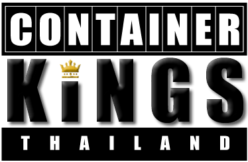INSULATION
A standard shipping container is very poorly insulated. The walls are solid steel and the floor is normally 28mm plywood with nothing under neath.
It is VERY important to insulate the container properly to ensure both a comfortable home and in many cases to comply with local building regulations.
In Thailand the temperature is normally between 30 and 40 degrees centigrade which means without insulation the inside of the container will be extremely hot.
Floor Insulation
Most shipping containers have a plywood floor which sits on steel rafters and is actually hollow underneath. In our opinion it is always best to remove the floors and then weld a solid steel plate to the underside of the container. This can then be treated with primer and bitumen or other substances to protect from the elements. We would then add a minimum of 100mm insulation in the floor before laying new flooring in plywood or viva board etc.
Walls & Ceiling Insulation
On all our containers we will use a UV barrier paint as the initial coating, this provides the first level of insulation. We then add galvanised steel stud work frame to the interior which is then filled with fiberglass insulation with a foil protection. This gives an R value of around 4.5 per inch.
Some containers may prefer to insulate on the exterior. Again this can be done by adding a framework and filling with insulation.
Types Of Insulation
There are many types of insulation which can be used and choosing the right one depends on your particular installation and also the local building regulations. All the material we use are normally standard materials which are permitted in most building codes. The type of insulation will depend on your budget, climate you live in and also the time scale you have to install.
EPS Foam (Expanded Polystyrene Foam) (R Value 3.7 – 4.0)
EPS foam is the white foam you normally see in packaging, it comes in large sheets and can easily be cut with a hot knife or wire. It is easy to work with but it can be difficult to fill all gaps due to its rigidness.
EPS foam is flammable and in the event of a fire burn with black smoke
PU Foam (Polyurethane Foam) (R Value 3. 6 – Open Cell / R Value 5.5 – 6.5 Closed Cell)
PU foam is probably the most expensive type of insulation and also the messiest to install. It is normally sprayed onto the container and can be done very quickly. The good thing about PU foam is that it gets into all the nooks and crannies to every area of the container is insulated.
PU foam is flammable and in the event of a fire can burn at high temperatures.
Open Cell PU – This is a more softer type of PU foam and is spongy to the touch. The cells are made from small bubbles which have broken walls allowing air to fill them. The open wall means that the material is more spongy and has a lower R Value.
Closed Cell PU – This is a much more dense foam and the density can be controlled by the mixture. The cells are made from small air bubbles which are sealed like tiny balls which means the final material is stronger, more ridgid and has a higher R Value.
PE Foam (Polyethylene Foam) (R value 3.0 – 3.5)
This foam normally comes on large rolls and have an aluminium foil coating on one side. It is fairly easy to work with and can be cut with a sharp knife / hot wire. It can be difficult to pack into all the small holes.
PE Foam is flammable and although many do contain fire retardants it will burn on the event of a fire.
Fiberglass Wool (R value 2.7 – 3.0)
Fiberglass is our preferred choice of insulation. Fiberglass wool is made of recycled glass and sand formed into tiny strands. Fiberglass is easy to work with and can be cut with a regular knife or torn apart. It is irritating and itchy if you get it on your skin during install but most of the good brands now also come with a foil coating on both sides.
The good thing about fiberglass is that it is an inorganic material, and as such, is a noncombustible insulation material that is not flammable.
Rock Wool (R Vaule 3.1 – 4.0)
Rockwool is very similar to fiberglass although a lot more expensive. Rock wool combines man made materials with rock to form tiny strands. This normally comes in rolls or flat sheets and is fairly easy to work with. It has a higher R Value than fiberglass.
Rockwool is a very good fire insulator.
Sandwich Panels EPS / PU (R Value – 5.5 – 7.5)
These are normally pre-fabricated panels made with 2 sheets of steel and a center core of foam. The panels are normally 1200mm x 2400mm in size. Sandwich panels are fairly expensive but do not need a stud work frame to fix to so therefore you do save money on the internal work and time. Sandwich panels are harder to install and take time to finish the corners and joins properly.
Sandwich panels normally have a foam core so therefore are not fire proof.

